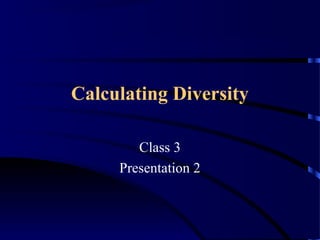
Species Diversity Concepts
- 2. Outline • Lecture • Class room exercise to calculate diversity indices
- 3. Why quantify biodiversity? • Initially thought that more diversity = more stable ecosystem* • Now used to measure and track changes *MacArthur, R. 1955. Fluctuations of animal populations and a measure of community stability. Ecology 35:533-536
- 4. How do we measure biodiversity? • Use functional categories – Ecosystem, species, genetic • Use theoretical categories* – Alpha – Beta – Gamma * Whittaker, R.H. 1960. Vegetation of the Siskiyou Mountains, Oregon and California. Ecol. Mono. 30:279-338.
- 5. Alpha diversity • Diversity within a particular sample • E.g. the number of species surveyed
- 6. Beta Diversity • Changes in sample composition along an environmental gradient • E.g. composition of forest stands on the slope of a mountain
- 7. Gamma Diversity • Diversity due to differences in samples when all samples combined • E.g. diversity of a forest landscape
- 8. Describing Communities • Two methods – Describe physical attributes (e.g. age class, size class) – Describe number of species and their abundance
- 9. Biodiversity • Diversity of living things • Term often misused and overused • Current focus in conservation studies • Includes interest in genetic, species and ecosystem diversity • We will use species as our focus but concepts can be used for genetic and ecosystem diversity as well.
- 10. Species Richness • Number of species in a community • The simplest measure • Can count all spp only is few simple ecosystems • Does not consider number of individuals • Difficulties – When is it a specie? • Aphids • Clonal plants – Cannot count all species with limited time
- 11. Species Richness • How? • Identify organism groups of interest • Identify boundaries of community • Survey area for organisms of interest
- 12. Species diversity • Species richness not very informative • Each community has 5 spp & 50 individuals Spp 1 Spp 2 Spp 3 Spp 4 Spp 5 Comm A 10 10 10 10 10 Comm B 46 1 1 1 1
- 13. Diversity indices • To get a better description of the community we need to get a measure of spp richness and evenness of their distribution • We usually use an index to represent several different measures – E.g. stock markets, air pollution, etc.
- 14. Diversity indices • Over 60 indices used in ecology • Indices used to measure proportional abundance • Two major forms: – Dominance indices (e.g. Simpson index) – Information indices (e.g. Shannon Weiner index)
- 15. Simpson Diversity Index (D) – Simpson’s index considered a dominance index because it weights towards the abundance of the most common species. – measures the probability two individuals randomly selected from a sample will belong to the same category – For example, the probability of two trees, picked at random from a tropical rainforest being of the same species would be relatively low , whereas in the boreal forest would be relatively high.
- 16. Simpson Diversity Index (D) Ds = Σ(n1(n1 -1)/N(N-1)) Where: Ds= Bias corrected form for Simpson Index n1= number of individuals of spp 1 N = Total number of spp in community In this form as diversity increases index value gets smaller
- 17. Simpson Diversity Index (D) • To make it easier to read the index is often read as: • Reciprocal i.e. 1/ Ds • Complimentary form: 1- Ds • Here as diversity increases Index value increases
- 18. Simpson Diversity Index (D) Sugar Maple Red Maple Yellow Birch Red Oak White Ash Total # Trees 56 48 12 6 3 125 ((56*55)/(125*124))+ ((48*47)/ (125*124)) + …………. …. ((3*2)/125*124)) = 0.35509 See Excel Show how index changes
- 19. Simpson Diversity Index (D) • Complimentary form = 1-D • = 1-0.35509 = 0.6449 • Reciprocal 1/D • 1/0.35509 = 2.816
- 20. Shannon-Weiner Index (H') • The index measures the uncertainty of a category in a particular set • It is a measure of evenness • For example, very low uncertainty the letter y is the next letter in this string: yyyyyyy (H' = 0)
- 21. Shannon-Weiner Index (H') • Assumptions: – All species represented – Sample randomized (equal probability of being selected in the sample) H' = -Σ pilnpi pi=proportion of the ith species ln=natural logarithm
- 22. Shannon-Weiner Index (H') Sugar Maple Red Maple Yellow Birch Red Oak White Ash Total # Trees 56 48 12 6 3 125 Pi 56/125 0.44 48/125 0.38 12/125 0.096 6/125 0.048 3/125 0.024 -plnp 0.359 0.367 0.224 0.146 0.089 1.187
- 23. Shannon-Weiner Index (H') • Index affected by both number of species and evenness of their population • Diversity increases as both increase • Diversity maximum when all species equally abundant
- 24. Evenness • Can use Shannon Weiner index to get a measure of evenness • First calculate Hmax • Evenness = H‘/ Hmax • Evenness will vary between 1 and 0
- 25. Evenness • In the last example • H‘= 1.1875 • Hmax = 1.609 • Therefore E = 1.1875/1.609 = 0.738 • The closer to 1 the more even the populations that form the community
- 26. Questions?
